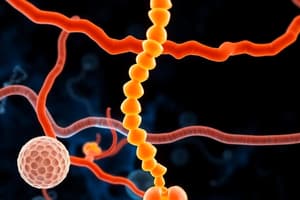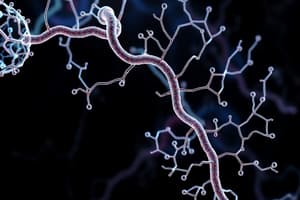Podcast
Questions and Answers
What is the primary molecule that enters the tricarboxylic acid cycle?
What is the primary molecule that enters the tricarboxylic acid cycle?
- NADH
- Fumarate
- Acetyl CoA (correct)
- Oxaloacetate
How many molecules of CO2 are released for every two carbons that enter the cycle?
How many molecules of CO2 are released for every two carbons that enter the cycle?
- Two (correct)
- Three
- Four
- One
Which of the following best describes the role of the tricarboxylic acid cycle in energy metabolism?
Which of the following best describes the role of the tricarboxylic acid cycle in energy metabolism?
- It produces ATP directly through substrate-level phosphorylation.
- It plays a key role in the oxidation of acetyl CoA. (correct)
- It generates glucose from fatty acids.
- It is the central pathway for amino acid catabolism.
In the context of energy metabolism, what happens to the carbon skeletons of acetyl CoA during the tricarboxylic acid cycle?
In the context of energy metabolism, what happens to the carbon skeletons of acetyl CoA during the tricarboxylic acid cycle?
Which metabolic pathway is directly connected to the tricarboxylic acid cycle in terms of feeding in acetyl CoA?
Which metabolic pathway is directly connected to the tricarboxylic acid cycle in terms of feeding in acetyl CoA?
What is the primary function of glucokinase in the liver?
What is the primary function of glucokinase in the liver?
Why is a high Vmax significant for glucokinase's function?
Why is a high Vmax significant for glucokinase's function?
How does glucokinase's activity impact glucose levels in the liver?
How does glucokinase's activity impact glucose levels in the liver?
What would be the consequence of glucokinase having a low Vmax?
What would be the consequence of glucokinase having a low Vmax?
In the context of enzymatic activity, what does the term 'Vmax' refer to?
In the context of enzymatic activity, what does the term 'Vmax' refer to?
What is the role of phosphofructokinase-1 (PFK-1) in glycolysis?
What is the role of phosphofructokinase-1 (PFK-1) in glycolysis?
Which substrate is phosphorylated by phosphofructokinase-1 (PFK-1)?
Which substrate is phosphorylated by phosphofructokinase-1 (PFK-1)?
What characteristic of the reaction catalyzed by PFK-1 underscores its importance in metabolism?
What characteristic of the reaction catalyzed by PFK-1 underscores its importance in metabolism?
Which of the following best describes the nature of the phosphorylation of fructose 6-phosphate by PFK-1?
Which of the following best describes the nature of the phosphorylation of fructose 6-phosphate by PFK-1?
What is the primary consequence of the phosphorylation of fructose 6-phosphate in glycolysis?
What is the primary consequence of the phosphorylation of fructose 6-phosphate in glycolysis?
What is the most common biochemical cause of congenital lactic acidosis?
What is the most common biochemical cause of congenital lactic acidosis?
Which enzyme component of the PDH complex is primarily deficient in pyruvate dehydrogenase deficiency?
Which enzyme component of the PDH complex is primarily deficient in pyruvate dehydrogenase deficiency?
What type of acid-base disturbance is associated with pyruvate dehydrogenase deficiency?
What type of acid-base disturbance is associated with pyruvate dehydrogenase deficiency?
How common is pyruvate dehydrogenase deficiency as a biochemical disorder?
How common is pyruvate dehydrogenase deficiency as a biochemical disorder?
What is the impact of pyruvate dehydrogenase deficiency on pyruvate metabolism?
What is the impact of pyruvate dehydrogenase deficiency on pyruvate metabolism?
What role does citrate primarily serve in the TCA cycle?
What role does citrate primarily serve in the TCA cycle?
How does citrate contribute to fatty acid synthesis in the cytosol?
How does citrate contribute to fatty acid synthesis in the cytosol?
Which statement accurately describes the metabolic function of citrate?
Which statement accurately describes the metabolic function of citrate?
What is the importance of acetyl CoA derived from citrate?
What is the importance of acetyl CoA derived from citrate?
In terms of metabolic pathways, citrate has a significant role because it:
In terms of metabolic pathways, citrate has a significant role because it:
Study Notes
Glucokinase
- High Vmax allows for the liver to remove large amounts of glucose from portal blood
Phosphorylation of Fructose 6-Phosphate
- Phosphofructokinase-1 (PFK-1) catalyzes the irreversible phosphorylation of fructose 6-phosphate
- It is the most important control point in glycolysis and is the rate-limiting step
The Tricarboxylic Acid (TCA) Cycle
- Takes place in the mitochondria and is a central pathway for energy metabolism
- Two carbon units enter as acetyl CoA and two CO2 are released
Citrate
- Functions as an intermediate in the TCA cycle
- Provides a source of acetyl CoA for the cytosolic synthesis of fatty acids
Pyruvate dehydrogenase Deficiency
- It is a rare biochemical cause of congenital lactic acidosis
- Deficiency in the E1 component of the PDH complex is the most common cause
Studying That Suits You
Use AI to generate personalized quizzes and flashcards to suit your learning preferences.
Related Documents
Description
This quiz covers essential biochemical processes, focusing on glucokinase, phosphorylation of fructose 6-phosphate, and the tricarboxylic acid cycle. It also addresses pyruvate dehydrogenase deficiency and its implications. Test your knowledge on these critical metabolic pathways and their control mechanisms.




